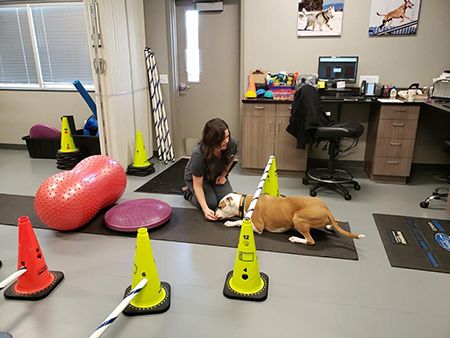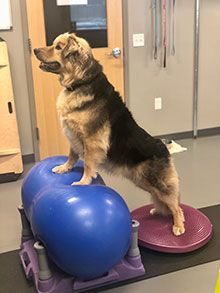Rehab techs: Let dogs noses do the talking
Your veterinary patients sense of smell is stronger and more precise than your own, and thats nothing to thumb your nose at. Instead, use it to help your rehabilitation processfor pets sake.

Drenker helps veterinary patient Leonidas (Leo for short) perform a crawl. She says this is great for elbows and knees (stifles) in particular, specifically with the flexion of both of those joints. Leo presented with elbow and knee issues, so Drenker wanted to focus on range of motion and strengthening surrounding muscles. (All photos courtesy of Kelsey Drenker, CVT.)
Finn starts shuffling his back legs as he's walking. He's panting more, and his tongue is now hanging out the side of his mouth. I ask him to perform one more repetition of a figure eight, but he's losing interest in the exercise. I ask him, “Are you getting tired, buddy?”
His owner quickly replies, “Oh, no, he's not tired! He does much more exercise than this at home.”
It's common knowledge that a dog's strongest sense is smell. Oftentimes due to anthropomorphism we forget that this is the case, but it's estimated that a dog's sense of smell is 10,000 to 100,000 times more precise than a human's.
This is in part because of the fact that dogs have a separate region in the back of their nose that's solely responsible for olfactory senses, while the rest of inhaled air is involved in respiration. It's thought that dogs have up to one-third of their brain dedicated to olfactory cells, and receptors within this specialized area of the nose are constantly sending signals to the brain for analysis.
Now, bring an animal that has this extraordinary sense into a facility where there have been other animals and where food is a primary motive in order to perform therapeutic exercises. This naturally puts the dog's olfactory system into overdrive, which in turn is constantly stimulating their brain. While the dog may not appear mentally tired because they're engaged in their environment by treats and other scents we can't detect, they're being physically exerted in ways that aren't common to them otherwise.
Therapeutic exercise, under the umbrella of physical rehabilitation, is about precise movement to engage particular

Drenker's own dog, Bear, is working with a rehab peanut while standing on a disc. These are great for core work and pelvic limb muscle engagement, she says.muscle groups for strengthening, conditioning, active stretching and active range of motion. To accomplish these goals, rehabilitation technicians are often asking dogs to step on unsteady objects to challenge their balance, lift their limbs higher than normal over obstacles and use supplemental tools such as land or underwater treadmills.
It's crucial to take into consideration that many dogs in rehab are recovering from an injury, whether it is acute or chronic, medically managed or post-operative. These dogs may have muscle atrophy due to activity restriction or compensation with injury, which has decreased their overall strength and increases their rate of muscle fatigue. While it may not appear to be the cardiovascular exercise owners are used to doing alongside their furry companions such as walking, running, hiking or playing fetch, muscle fatigue can happen sooner in the rehabilitation environment due to the fact that we're asking them to perform physical exercises that aren't often a part of their daily life.
All animals are at risk of increased injury occurrence when performing exercise during muscle fatigue. When fatigued, muscle fibers are not able to perform at the same level of intensity and therefore have a decreased ability to produce force. Continued exercise in this state could cause structural damage to muscle cells and supportive tissue.
It's our job as rehabilitation technicians to be a voice for the animals we work with and watch for physical signs of fatigue as opposed to the mental signs. The physical signs can easily be overshadowed due to the the mental engagement of being in the rehab facility and working with food-driven animals. Some common signs of fatigue can be seen as excessive panting (particularly with the tongue hanging out the side of their mouth), shuffling limbs when walking and not performing exercises with proper form (compensation). If there's any doubt of causing injury, always consult your veterinarian.








